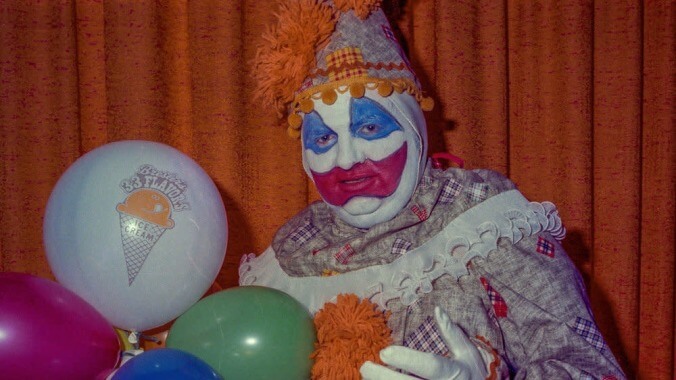John Wayne Gacy Photo: NBCUniversal
The word “clout” has a very specific meaning in Chicago. Basically, if you’re just some regular schmuck and you want to put an addition on your house, you have to file paperwork and get permits and make sure everything is up to code. If you have clout, you just build the thing, and the city will stop by with a concrete mixer to see if you need any help (free of charge, of course). Clout is a byproduct of the Chicago political machine, and if you want a government job that pays well and has very few responsibilities, you better hope you know someone who has it. Clout also comes in handy if you get charged with a crime, and can delay, oh, let’s say, an investigation into several missing persons who all worked for your construction company in the mid-to-late ’70s long enough for a dozen more young men to vanish.
Clout is just one of the many intensely Chicago things about John Wayne Gacy: Devil In Disguise, a series that reinforces the generally solid advice to never trust anyone who goes by both their first and middle name. Most of this six-hour documentary is a by-the-numbers affair, giving the official version of the John Wayne Gacy story as told by a series of middle-aged and older white guys with bristly mustaches and a tendency to pronounce their “O”s like “A”s. (Cops, lawyers, reporters—you know the kind.) Supplementing their recollections are interviews with relatives of Gacy’s victims, as well as Gacy’s sister and a handful of former friends, all of whom have told their story enough times that they’re clearly not bothered by it anymore. Then the last episode pivots into an allegation that won’t surprise anyone familiar with how power is wielded in Chicago: That due to a combination of indifference and incompetence, local law enforcement investigated Gacy—a well-known and well-liked Democratic precinct captain—as little as they possibly could, and may have misidentified at least one of his victims.
Besides Gacy’s political connections, a key reason for that is because Gacy committed sexual murders against other men, and the homophobia of the era meant that victims who escaped his clutches were not taken seriously. This point isn’t given as much oxygen in Devil In Disguise as more conspiratorial ideas about Gacy’s alleged accomplices, as well as a snuff-movie operation that was rumored to have existed in the city around the same time as Gacy’s murder spree. And that’s unfortunate, not only because—unlike snuff films—the existence of homophobia is not up for debate, but because one of the most affecting moments in the series comes from the partner of a Gacy survivor who later died by suicide. The man’s contempt and anger are palpable when he explains that, at the time, the Chicago police didn’t think that it was possible for a gay man to be raped.
Devil In Disguise doesn’t linger very long on that statement, or indeed any of the reasons why Gacy was able to get away with murder for so long. Much like Netflix’s recent Night Stalker series, Devil In Disguise bypasses sociopolitical commentary to focus on methodically, chronologically ticking off all the familiar boxes: Gacy’s childhood head injuries, Pogo the clown, the Jaycees, and his sodomy conviction 10 years before the bodies of 29 people were found in the crawlspace of his neat brick suburban bungalow. (The story of how that was discovered is also quintessentially Chicago: Gacy had become chummy with the cops who were surveilling him, and one of them went into the house to use the bathroom when “the heater kicked on” and the unmistakable odor of decay started wafting through the vents.)
Devil In Disguise’s visual style is similarly unremarkable, although its combination of stock footage and interviews conducted in hotel rooms will tweak the nostalgia centers of Dateline fans’ brains. (The end credits in particular have an endearing network newsmagazine je ne sais quois.) And the only thing that footage from a jailhouse interview conducted by FBI profiler Robert Ressler in 1992 adds to the series is frustration: Gacy, so ensconced in privilege that he thought he was untouchable even after a decade in prison, refuses to own up to his crimes, claiming that he had “no idea” how all of those corpses ended up under the floorboards of his home. He even has the audacity to say that it wouldn’t be “fair to the victims” for him to be put to death, while telling one of his cop buddies that finding their bodies was “your job.” He’s a whiny, entitled, annoying prick, in other words, and if you didn’t hate him going in to the series, you will after watching it.
But why? Why go over the familiar beats of an already infamous story? Were it not for its final hour, there would be no real reason for Devil In Disguise to exist. And the reason we do get—because there are still six victims who have never been identified, and many unanswered questions about the investigation—is more about the culture of impunity surrounding the case than the killer himself. John Wayne Gacy is dead, and Devil In Disguise is correct in that whatever is left to say about him isn’t a horror story about an evil criminal mastermind, but a cautionary tale of a serial predator who went unpunished because he looked and acted like the men who were supposed to stop him.
Where the series falls short is that, in its attempts to be a definitive account, its interrogation of the Gacy case gets caught up with the myth it’s debunking. One troublesome point that comes up again and again is that interviewees whose methods and motives are openly questioned on some subjects are taken at their word on others. That’s an issue that comes up a lot when talking about the lives and criminal careers of serial killers; it’s a particularly difficult nut to crack, given that the only living witness to these events is, 99 times out of 100, also a pathological liar with a narcissistic aversion to taking responsibility for their actions. The funny thing here is that one could use the same terms to describe the Chicago Police Department. In fact, some of the interviewees in this series do. No wonder they got along so well.









































